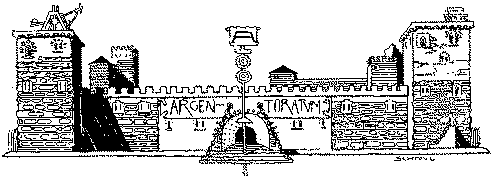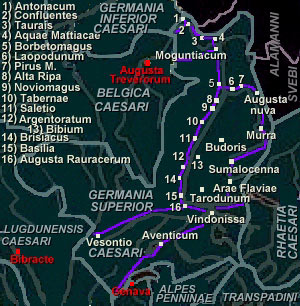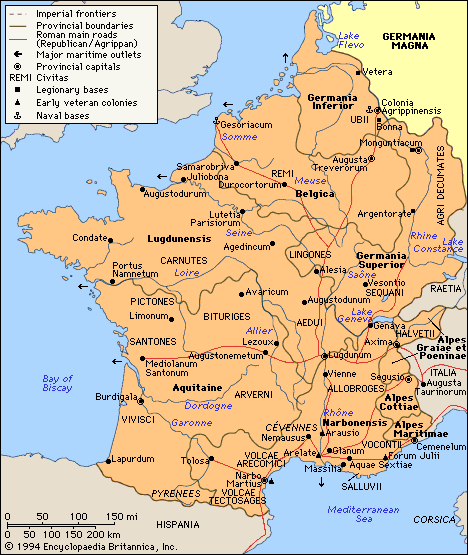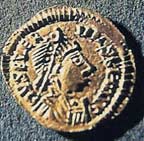| |
From Barbarians to Rome
|
According to legend, Strasbourg, originally known as Argentorate, traces
its ancestory back to the mythical Trébéta who was the son of Sémiramis and the
supposed father of the Trévires and Triboques (the Celts of Trève and lower
Alsace). Archeologists and historians have given justice to this myth by taking
us through their excavation of the earliest traces of Strasbourg's history which
recount the civilization of Rhénanie 700,000 years ago.
Before the creation of Argentoratum by the Romans in 12 B.C., the origins of
Strasbourg may be traced back to the existence of Argentorate. Argentorate was a
large celtic village with at least one permanent activity. This site had been
previously occupied by a varied group of people who completed sporadic and
successive activities.
Contrary to a persistant legend, the Romans did not arrive to find a virgin
forest occupied by a few uncultivated barbarians who passed their time trying to
painstakingly maintain the little light they had thusfar shed on humanity. In
reality, people had been present in this sector for already 700,000 years:
Alsace had five thousand years of agricultural development and two thousand
years of metalurgy. Different groups of people had come to Alsace from Central
Europe and the occidental borders of Europe as far as the Atlantic and the
English Channel, in addition to the Black Sea and the Aegean Sea. Their presence
is attested to by the fabulous collection of objects they left behind, including
jewels and arms, which may be found in the Archeological Museum of Strasbourg.
Geography directs history: this site, from the outset, due to its geographical
complexity and diversity paved the way for fascinating events.
Concerning the original location of Strasbourg, one is obliged to highlight
the following two perfectly obvious and contradictory aspects:
-the location
was advantageous as it represented a potentially powerful circulation hub with
its dense system of water canals and land paths;
-the location was
unexceptional, almost adverse, as it was an essentially inundated zone which
meant that the site would not be conducive to protecting the health of its
residents. In particular, malaria would not be eradicated before the 19th
century!
Favorably disposed, it is by its situation at the center of an important long
narrow excavation dug into the earth from the Rhine which was the result of the
successive collapsing of the earth's crust in the Tertiary Period. In this
"trench" which stretches from the Mediterranian to the Lake Mjösa in Sweden, the
Rhine is but a late host. The Rhine's contribution to the location is
substantial: the Alpine alluvial deposits and its sand and gravel sediments set
the stage for an imposing layer of underground water which would aliment the
springs.
Water is everywhere, whether it be underground (two to eight meters below the
earth) or fluvial. Water plays a dual role in the history of the city: assisting
communication via canal transport routes as well as providing a natural defense.
In addition, the hills of limestone at the foot of the Vosges mountains
provided fertile earth for vineyards which would produce excellent wines,
playing an important role in the later economy of Strasbourg.
The climate, on the other hand, did not appear advantageous. The
semi-continental climate favors the extremes; it is either very cold or very
hot. Nonetheless, despite all the negative factors, this location would be
accepted, built and developped by succesive generations of varied people.
Ideally located at the center of the Rhine "trench", this location offered a
relatively easy south-north access. The two banks of the Rhine were endowed with
land paths. As the preferred main route of the Roman penetration towards the
north, the Rhine was the cultural and economic backbone from Northern Italie to
Holland from the High Middle Ages to the Renaissance, from the 12th to the 13th
centuries. To this day, this region continues to be the most industrial as well
as the most populated of Europe.
Overall, this location was well-balanced between the fertile land due to
alluvion and the Rhine. The forests were cleared, the trees cut down and small
villages would be established on this agricultural land. Fishermen, hunters,
daring travelers and runaways would venture upon this place which was not the
most hospitable. However, Argentorate, the celtic establishment, would give
birth to Argentoratum, the Roman camp. Strasbourg's history had only just begun.
 In fact,
Strasbourg should have been named Drusenheim, as it was founded by the Roman
General Drusus, the brother of Tibère. General Drusus constructed more than
fifty forts along the Rhine river. These forts, built from Switzerland to
Holland, constituted a sort of Maginot line before its time. This development
took place between 12-16 B.C. One may suppose that under Emperor Augustsus,
Argentorate was composed of five or six thousand inhabitants, who for the most
part were foreigners who had not set out to settle there. Thus, this small town
had already taken on a very cosmopolitan character which was also a bit
unstable. In fact,
Strasbourg should have been named Drusenheim, as it was founded by the Roman
General Drusus, the brother of Tibère. General Drusus constructed more than
fifty forts along the Rhine river. These forts, built from Switzerland to
Holland, constituted a sort of Maginot line before its time. This development
took place between 12-16 B.C. One may suppose that under Emperor Augustsus,
Argentorate was composed of five or six thousand inhabitants, who for the most
part were foreigners who had not set out to settle there. Thus, this small town
had already taken on a very cosmopolitan character which was also a bit
unstable.
Different legions succeeded one another in what had become a legionary camp.
An important period of growth and relative prosperity took over the military and
civil agglomeration. This agglomeration would, little by little, take on the
same proportions of an insular island. The Germanic tribe, which included the
Suèves, submitted to a Roman peace. Henceforth, the Roman Empire's border would
find itself projected towards the east, beyond the Black Forest. Argentoratum
remained the most important logistical homefront base for the Romans until 260
A.D.
In the new civilization that developped on the border of the Roman Empire's
decadence, Strasbourg was an ardent melting pot in which the adverse elements of
this new world dissolved. In 352, the Alamanni and the Franks totally destroyed
about forty of the fortified towns along the Rhine, including Strasbourg. But
Rome decided to reconquer Argentoratum and drive the Alamanni out. Caesar Julian
, known as the "Apostate" who opposed Christianity, would defeat the Alamanii
troups in 357 A.D. Thanks to this battle, the Roman Empire had a short respite.
The city of Argentoratum was partially restored.
In 406 A.D. an ethnic downpour covered the city of Mayence or Mainz, on the
German side of the Rhine. Under the Huns' pressure the Burgondes, Vandales and
the Suèves pounced on Gaul, the region which is now known as France. It was
Attila who definitively destroyed the city in 451 A.D. After the devastating
passage of the Huns, the Alamanni established themselves as the rulers of the
region. During the next several decades, history would lose all trace of
Argentoratum.
|
|
Germania Superior
Easternmost Province of Gallia
Diocese
Provincial History
In early historic times the Germanic
culture settled along either side of the lower Rhine river and the Celtic tribes
similarly along the upper. Bridged and crossed by Julius Caesar in 55 and 53 CE,
the Rhine became the boundry of Roman Gaul and the frontier of the Empire from
from Lake Constance to its mouth at Lugdunum Batavorum (Leiden, Neth.).
Under the Emperor Augustus the provinces of Germania Superior and
Germania Inferior were established on the other side of the Rhine, as part of
the effort to expand the Roman frontier to the Elbe river, but this halted after
the disasterous Varus disaster in 9 CE.
After the Civilis revolt during the Year of the Four Emperors (69
CE) the area along the Rhine became a military frontier. The Emperor Domitian
reformed the Germania provinces out of Belgica province in Gaul; the border of
lower Germany now ended at the Rhine.
South of Bonna (Bonn) the boundary of the Roman Empire was marked
by the limes (Roman fortified frontier) well east of the river. The Romans under
the Flavian emperors began annexing the area in AD 74 to secure better
communications between the Rhine and Danube armies. This latter area was annexed
to Germania Superior and called the Agri Decumates. Today this zone is the Black
Forest and adjoining areas of what is now southwestern Germany between the
Rhine, Danube, and Main rivers. The name may imply earlier occupation by a tribe
with 10 cantons. According to Tacitus, the territory was previously inhabited by
the Helvetii; later, Gauls settled there. The Romans were displaced from the
Agri Decumates by the Alemanni in about 260 CE.
Life on the Rhine
Once the frontiers had stabilized,
cultural and commercial contacts were inevitable and influential, and as
important as armed conflict. Although the frontier was heavily fortified, it was
not a hindrance to the passage of trade or people. Rome exported fine pottery,
glass, and metalwork across the Rhine. In return, raw materials such as amber,
leather, and slaves went back across the frontier. "Free" Germans also served in
Roman armies.
Border raids were constant, and there were periodic larger
disturbances. Between about 150 and 200 CE a whole series of Germanic groups
moved south along the river valleys of central and eastern Europe. This
migration was violent and highly destructive. About 150 CE the Marcomanni, a
Germanic tribe, moved south into the middle Danube region. In 167 they got as
far as Italy itself, forcing the Emperor Marcus Aurelius and his son spent the
next 20 years curbing their inroads.
These migrations resulted in great violence along the entire
frontier during the 3rd century. Parts of Gaul suffered greatly, and Germania
Superior was on the front line of the conflicts. Although Goths ravaged the
Danube region, even killing the emperor Decius in 251, intensive campaigns
brought the Germanic tribes back under control, so that by about 280 stability
had returned to the Rhine and Danube.
The Roman army and an alliance system involving, among others,
Franks, Alemanni, and Goths maintained the frontier until about
370
Germania Superior is an Imperial province over which the
Imperator is proconsul. It is governed by a legate of consular rank who is in
command of both the provincial administration as well as all the military forces
in the province.
The provincial capital is at Moguntiacum, in the north of the
province.
Each city in Germania Superior is governed by either a Decuriones
(high councilor) or a Curiales (mayor). Decurions are appointed by the
provincial governor.
| |
Cities in Germania
Superior: |

|
Argentoratum |
Aquae |
Moguntiacum |
|
Borbetomagus |
Aventicum |
Augusta
Rauricorum |
|
Vindonissa |
Basilia |
Besontio |
|
Arae Flaviae |
Castra Regina |
|
Gallia Diocese

The Army of Germania Superior:
Legion
VIII Augusta
|




